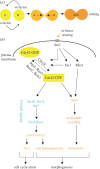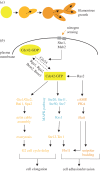Functional genomics in the study of yeast cell polarity: moving in the right direction
- PMID: 24062589
- PMCID: PMC3785969
- DOI: 10.1098/rstb.2013.0118
Functional genomics in the study of yeast cell polarity: moving in the right direction
Abstract
The budding yeast Saccharomyces cerevisiae has been used extensively for the study of cell polarity, owing to both its experimental tractability and the high conservation of cell polarity and other basic biological processes among eukaryotes. The budding yeast has also served as a pioneer model organism for virtually all genome-scale approaches, including functional genomics, which aims to define gene function and biological pathways systematically through the analysis of high-throughput experimental data. Here, we outline the contributions of functional genomics and high-throughput methodologies to the study of cell polarity in the budding yeast. We integrate data from published genetic screens that use a variety of functional genomics approaches to query different aspects of polarity. Our integrated dataset is enriched for polarity processes, as well as some processes that are not intrinsically linked to cell polarity, and may provide new areas for future study.
Keywords: Saccharomyces cerevisiae; functional genomics; genetics; microscopy; polarity; proteomics.
Figures





References
-
- Botstein D, Fink GR. 2011. Yeast: an experimental organism for 21st century biology. Genetics 189, 695–704 (doi:10.1534/genetics.111.130765) - DOI - PMC - PubMed
-
- Bi E, Park HO. 2012. Cell polarization and cytokinesis in budding yeast. Genetics 191, 347–387 (doi:10.1534/genetics.111.132886) - DOI - PMC - PubMed
-
- Cullen PJ, Sprague GF. 2012. The regulation of filamentous growth in yeast. Genetics 190, 23–49 (doi:10.1534/genetics.111.127456) - DOI - PMC - PubMed
-
- Drubin DG. 1991. Development of cell polarity in budding yeast. Cell 65, 1093–1096 (doi:10.1016/0092-8674(91)90001-F) - DOI - PubMed
-
- Pringle JR, Bi E, Harkins HA, Zahner JE, De Virgilio C, Chant J, Corrado K, Fares H. 1995. Establishment of cell polarity in yeast. Cold Spring Harb. Symp. Quant. Biol. 60, 729–744 (doi:10.1101/SQB.1995.060.01.079) - DOI - PubMed
Publication types
MeSH terms
Substances
LinkOut - more resources
Full Text Sources
Other Literature Sources
Molecular Biology Databases

